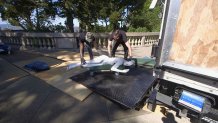With its mournful, ghostly white bodies laying in clusters, and a lone figure leaning against a barbed wire fence, San Francisco’s Holocaust Memorial near the Legion of Honor museum summons the chilling emotions of one of history’s most horrific events.
In a way, artist George Segal’s memorial is a survivor — 35 years in the harsh elements and weathering several hate attacks that left some of its figures covered with anti-Semitic graffiti. So last week, it was a chance to finally give the memorial a chance to recalibrate as the San Francisco Arts Commission began removing the figures to perform a full restoration.
"So we’re moving it because it allows us to do a much more intensive restoration project," said Allison Cummings, the arts commission’s senior registrar. "So we need to remove the existing coatings on the bronze sculpture and replace them."

The eleven figures, which symbolize Jews in concentration camps, were created by Segal in 1984 as a gift to the city during Mayor Dianne Feinstein’s tenure. Their appearance gave the impression the figures were constructed of white plaster when in reality they were made of bronze and sheathed in white to resemble plaster — Segal’s artistic signature.
Last week, art restorers from the arts commission used saws to carefully cut the bolts gripping the figures to the cement, and loaded them into a moving truck bound for Oakland’s Preservation Arts for a full restoration. It was the first time since their installation 35 years ago that the pieces had been moved from their scenic perch overlooking the Pacific Ocean at the tip of the city.
"It’s a sensitive project and it’s a good time for us to do it," Cummings said.

The work will re-cover the cracking, weathered finish and restore its patina. The nonprofit Bay Area arts fundraising group ArtCare is raising $65,000 to pay for the work.
Local
"We’re taking care of a major monument in the city’s art collection, but we’re also raising the consciousness about it," said ArtCare’s Brian Gross.
Gross said the location of the monument, tucked into a small recess near the Legion of Honor’s parking lot was intended as an unexpected discovery for visitors. Still its remote location had been discovered numerous times by vandals who over the years penned swastikas on the figures. Each time, restoration crews would paint over the marks.

Gross hopes publicity surrounding the restoration will raise the memorial’s visibility and inspire more people to discover it and its poignant message.
"So it’s really important to take care of this and to bring it to public view again," Gross said.
The removal of the sculptures leaves a temporary vacancy at the memorial site, which is currently surrounded by fences and tarps. The figures are due back in late November — carrying with them their somber story from the long shadow of history.



